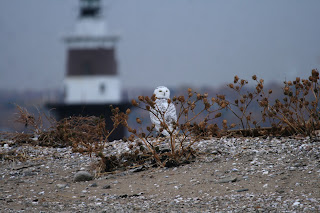The Great Backyard Bird Count started today, and what a day they picked to start this event.
At least in Long island Sound that is.
My friend Alvin join me on this trip, we left the dock at 08:20 2/18/11
with calm winds and above freezing temperatures.
We started today's count on the western side of the islands at Greens Ledge Lighthouse, this reflective photo shows the calmness in the air, what it doesn't show is the temperature.
The thermometer was rising rapidly on the mainland, yet out here I doubt we ever felt anything more than high thirties at best, the sound is still an ice box and does not warm as well as land.
We drove out to this Light house for a reason.
Cormorants.
Great Cormorants use these rocks that surround the Lighthouse as a perching area during the winter.
A look at the massive amount of white-wash shows that this is a popular resting place for these birds.
In total there were seven Great Cormorants here when we arrived.
Before I forget, left click on any of the photo's to enlarge.
Leaving Greens Ledge we headed eastward, not but a mile past the the lighthouse, cruising at 25mph I passed very close by to what I though was a lobster pot.
Alvin yelled OMG thats a seal!
I turned and looked, yes it was.
My problem here is why didn't it move or submerge?
They don't do this, I figured it was sick or injured.
I turned the boat around and pulled out my cell to dial either Norwalk or Mystic Aquariums,
for help.
The seal, head out of water never moved or flinched, as you can see from the above photo he appeared to be just sleeping, eyes are closed. This is something they do, just tread water and zone out.
Apparently this is what was happening here, as we came closer to this Grey Seal, it's huge eyes slowly opened, seemingly without a care in the world, he lazily looked at us and slowly turned, arching it's back and giving us a whale roll disappeared below the surface.
At first this looks like a rock in the water, but it is the rump of our almost 800 pound 10 foot long Grey Seal, submerging into the depths.
Check out how the water never leaves contact with the seals skin.
Just beyond the seal is Norwalk Seaport Association's Sheffield Island Lighthouse, in winter plumage.
The windows are buttoned up, plus there is still a good bit of snow on the ground.
This Lighthouse and Sheffield Island can be visited during the summer months via the Seaport's Ferry service on the C.J. Toth.
Visit their site here: http://www.seaport.org/
While your there, check out the Bird Cruise info.
Come onboard and join the Seaport and I for a great trip and some awesome views of the Norwalk Islands and its incredible wildlife this coming spring and summer.
Bird Counting was the reason for this trip, we had great numbers of several species.
Almost 600 Long-tail
800 greater Scaup (above photo)
Brant numbered close to 900.
The Seaducks, Brant, Goldeneye, Scaup, Scoter, plus Black Duck and others are expected around the Norwalk Islands and Long Island Sound during the winter.
What I never expected, showed up on Cockenoe Island.
From the boat I picked out one small finch/sparrow like bird that flittering on the shoreline.
I maneuvered the bow of the boat onto the shoreline, where I saw a number of small birds moving about.
Song Sparrows? Horned Larks? Snow Bunting? Savannah?
Lapland Longspurs?
All these were calculating in my head, what could they be?
Then I saw my first good look thru the bins.
Common Redpoll on Cockenoe Island, no way!
Here they were, on Cockenoe Island, one mile offshore, feeding on seed heads from this past years seashore plants.
They were in numbers, a minimum of forty five, maybe fifty.
Redpolls feeding along the slipper shells?
On a island in LIS?
This is Oystercatcher and Tern nesting ground. The last bird I would expect out here is the Redpoll, a arctic/sub arctic nesting bird of the conifers and scrublands.
They are never common in Connecticut, yet during occasional winters they will erupt in this State.
So far this winter, there have been a few reports in Connecticut, but mostly in areas inland from here.
They do show on rare occasion at Sherwood Island State Park, not but a few miles from here, but that is on the mainland. I guess they have no issue about flying a distance over water?
East White Rock came through again with ten Purple Sandpipers.
After big time search efforts, no other shorebird species were found.
Although we had a Killdeer on Chimmons this past Wednesday.
Great Cormorant numbers were at 14.
Status Quo for them around the islands this time of year.
As I mentioned in my last post, the Great Black-backed Gulls have moved back to their nesting islands, these birds are hanging out on the northern bar at Goose Island.
That is Peck's Ledge Lighthouse in the back round
Same lighthouse and same sandbar from a few years ago.
When Goose Island played host to this Snowy Owl for a few days.
I know its mid February, these gulls were not here a week ago, now there are almost 200 on the two nesting islands, looks like they are setting up shop to me.
This is the salt marsh behind the Norwalk Power Plant.
With the extra high tide this place was alive with water fowl.
Besides the Geese and Black Duck that are seen in the photo, Wood Duck, Northern Pintail, American Wigeon, Gadwall, Mallard, Green-winged Teal and others were abundant in the area




















+copy.jpg)



No comments:
Post a Comment